Alpinia zerumbet



Soft wooded
No secondary (woody) tissue being formed. The texture is fleshy and is soft, easy to cut.
Clumping
A plant that when multiplies forms a clump.This rhizomatous perennial has upright foliage and forms a clump. It has glossy dark green broad waxy lanced-shaped leaves and the yellowish fragrant tube-shaped flowers appear in a drooping raceme during spring.
Alpinia zerumbet (Pers.) B.L. Burtt & R.M. Sm. is naturally found in Tropical Asia from Japan to the Solomon Islands, Fiji, Nwe Guinea and Australia. It grows in the understorey in rainforest or along river margins and wet or shady places, forming thick thickets from sea level to an altitude of 200 m (656 ft). It has also naturalised in many countries from Africa to North America, South America and the Pacific Islands where it is regarded as invasive. It prefers a poorly to well drained organic rich moist to wet sandy-silty to clay loam, that is slightly acidic to slightly alkaline with a pH range from 6.0 to 7.5. It grows in a semi-shaded to full sun, humid protected position and is frost and drought tender.
The Shell Flower is grown for its attractive foliage, clumping habit and its flowers. It is planted in the understory in parks and gardens for a tropical effect or used around a water feature. It is also planted along borders for screening and can be grown in patio pots and planter boxes. In cool climates it is used as an indoors or glasshouse specimen. It establishes in 2 to 3 years, requiring little care and is planted in scented gardens. It is suitable for coastal or lowland regions only requiring reliable moisture. Once established it has a medium water requirement, (Scale: 2-drops from 3) and responds to mulching.
I.D. 605
UK hardiness zone H2
Climate zones H1, H2, 14 - 24
USDA Zone 10-12
Alpinia (al-PIN-ee-a) zerumbet (ZER-um-bet) syn. A. nutans / A. speciosa
Etymology
Genus:- - Alpinia – after Prospero Alpino (1553-1616), professor of Botany at Padua, Italy
Species:- zerumbet – of Arabic origin first used by 11th century physician and scholar, Serapion, for the aromatic roots of this family
Cultivar
'Variegata'
Variegated Shell Ginger
This plant is similar to the species and has yellow variegated leaves and is a popular indoor plant when young.
As a weed Alpinia zerumbet has a high risk of invading sensitive natural habitats as it spreads from seed or pieces of rhizome. It is commonly cultivated in urban gardens and is commercially available in nurseries. Plants produce over 3,000 seeds per square metre and are distributed by water and in garden waste. Once infestation has occurred it can change the character of natural ecosystems by forcing out the native species either by smothering or monopolizing resources. Control methods include digging up the plant and its roots and deposing off site (burning) or the use of herbicides, which has a limited effect. Seed heads should be collected and disposed of and the plant should not be used in sensitive areas, along water courses or in swampy places.
Zingiberaceae (ZIN-jee-ber-AY-see-ee)
Ginger Family
This monocot tropical family consists of aromatic, rhizomatous herbs that normally have sheathing leaves and bright bisexual flowers. They have upright cane-like stems that are normally short and form clumps with thick fleshy rhizomes that may have tuberous roots.
Distribution
The plants are mainly found in humid tropical lowlands from Indonesia to Malaya but are also represented in montane forests and tropical forests.
Diagnostic Features
The leaves are normally entire, elongated- elliptical with a prominent midrib and have parallel or pinnate lateral veins. They are arranged distichous or tufted with a variable length petiole or are sessile and have an open tubular sheathed.
The cylindrical to globose inflorescence are thyrse with bracts and are a raceme or a spike. They are normally terminal but sometimes lateral from the leaf bases and appear on a leafless shoot.
The bisexual zygomorphic flowers with a 3 lobed calyx and a 3 lobed corolla that is variable but normally tubular at the base. It has 3 stamens with one from the inner whorl that is fertile and the other two are petaloid staminodes fused to form a 2 to 3 lobed labellum. The ovary is inferior with 1 to 3 carpels that contain 1 to 3 locules. The ovules have basal or parental placentas.
The fruit is a dry or fleshy capsule with 3 valves and normally dehisces loculicidally. It contains many seeds with a red or white aril and the embryo is straight with starchy endosperm.
Note:
Many of the plants in this family are cultivated for their rich aromatic oils that are used in condiments, dies and for medicinal purposes. They are also commonly used as ornamentals for their colourful foliage or tropical appearance.
This plant tolerates between USDA zones 10a to 12a and grows to 3 m (10 ft)
Fahrenheit 30º to 55º F
These temperatures represent the lowest average.
Celsius -1.1º to 12.7º C

Attention
The information displayed on this plant is based on research conducted in our horticultural library and from reliable online resources. We also make observations of the plant that we photograph, and all care is taken to ensure the details are correct.
All photographs and data are covered by copyright. Apart from any fair dealing for the purpose of private study, research, reference or review, as permitted under the Copyright Act, no part including images and text may be reproduced by any means without written permission. The information presented in the map is only indicative and may contain errors and omissions. All inquiries should be addressed to sales@plantfile.com attention Peter Kirkland.

Simple
The leaf that is not divided.
Lanceolate
Broadest at the centre, three or more times long as broad (Lance-shape).
Alternate
Leaves are arranged alternately along the stem.
Entire
A leaf margin with no irregularities (smooth).
Tubulate
A flower that forms a tube shape.
Raceme
An inflorescence forming along a central stem of indefinite length with flowers having there own stems.| Jan | Feb | Mar | Apr | May | Jun |
| Jul | Aug | Sep | Oct | Nov | Dec |
The 25 mm (1 in) long orchid-like tubulate white flowers are tinged with purple and have a yellow variegated crinkled lip that is suffused in red. The flowers are arranged in a raceme that becomes nodding and is a feature of the plant. They appear from late spring to early summer.

Capsule
A dried dehiscent fruit, with an enclosing membrane normally containing may seeds."| Jan | Feb | Mar | Apr | May | Jun |
| Jul | Aug | Sep | Oct | Nov | Dec |
The vermilion globose ribbed capsule is up to 20 mm (¾ in) in diameter and the persistent calyx is attached to the apex. The small seeds are angled and very viable but the plant is commonly reproduced vegetatively.
The Shell Flower is grown for its attractive foliage, clumping habit and its flowers. It is planted in the understory in parks and gardens for a tropical effect or used around a water feature. It is also planted along borders for screening and can be grown in patio pots and planter boxes. In cool climates it is used as an indoors or glasshouse specimen. It establishes in 2 to 3 years, requiring little care and is planted in scented gardens. It is suitable for coastal or lowland regions only requiring reliable moisture.
Divide the rhizome during spring and place in a moist rich soil.
Rhizomes (General)
A rhizome is a stem that grows horizontally either below or on the surface of the soil with the shoots growing vertically as in bamboo and many grasses. The stems are composed of nodes and inter nodes giving it a segmented appearance.
Propagation is normally carried out by division during spring and autumn by cutting the rhizome into sections each with at least one node. Placed on a moist bed or slightly buried and kept warm will produce roots and shoots from the nodes.
PEST
NAME
Scale Insect
Various Scale Species
ORDER
Hemiptera
Description of the Pest
Generally scales are soft bodied insects that have a hard (armoured) or soft covering to hide under. They have piercing and sucking mouth parts that are attached to the host, feed off sap and soft scales commonly producing sweet honeydew, which in turn attracts sooty mould and ants.
The adult female has a circular or oval covering depending on the species and is up to 8mm across. The first stage (crawlers) hatch and wander around the leaf surface until finding a suitable place to suck sap, normally in colonies and the smaller male is relatively inconspicuous.
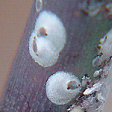 Hard Scale
Hard Scale 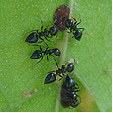 Soft Scale, attending Ants
Soft Scale, attending Ants
Cactus Scale (Diaspis echinocacti) has a circular greyish female and a narrow white male scale and is commonly found on house plants.
Chain Scales (Pulvinaria species) adult females are obvious with large group of eggs that are white or cottony-like, and the tiny young light green scales are flat and oval-shaped up to 2mm long. The legged nymphs are normally arranged from head to tail along the mid rib of the leaf, and may move to a new position to feed. They excrete honeydew and attract sooty mould and are found on Acacia and Acronychia species.
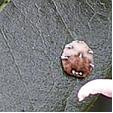 Chinese Wax Scale
Chinese Wax Scale
Chinese Wax Scale (Ceroplastes sinensis) is a domed wax scale that has dark spots around its margin and immature scales form waxy material around there margins.
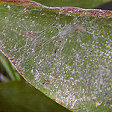 Fern Scale on Aspidistra elatior
Fern Scale on Aspidistra elatior
Fern Scale or Coconut Scale (Pinnaspis aspidistrae) appears as flecks up to 0.15mm long with a white covering over the male congregating on the underside of the fronds on the axils and among the sporangia causing them to turn yellow. Many species of fern are susceptible to infestation.
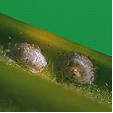
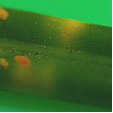 Flat Brown Scale
Flat Brown Scale
Flat Brown Scale (Eucalymnatus tessellates) are light brown up to 0.5mm long, flat and closely attached both sides of the leaf and causing yellowing of the foliage.
Juniper Scale (Diaspis carueli) is tiny and circular, white maturing to grey-black and as it feeds the needles turn yellow and die.
Oleander Scale (Aspidiotus hederae) is a pale yellow circular scale up to 3mm across and is found in dense colonies on the stem or leaves.
Tea-tree Scale (Eriococcus orariensis) are a creamy blue colour normally packed along the branches and are plump and rounded to 4mm across.

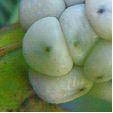 Wattle Tick Scale
Wattle Tick Scale
Tick or Wattle Scale (Cryptes baccatus) adult is domed, blue-slate colour with a leathery covering up to 10mm long. All stages of growth are found in groups of over forty, packed along the stems and normally tended by ants as they produce large amounts of honeydew. A serious pest of Acacia species found inland or coastal from temperate to sub tropical climates and commonly accompanied by Sooty Mould.
Toxic Scale (Hemiberlesia lataniae) is a tiny flat rounded scale up to 0.15mm long and is white to pale pink. It is normally found in colonies on the small branches and twigs of shrubs. It injects a toxic substance into the host as it sucks sap causing the death of the branch.
Wattle Scale (Pseudococcus albizziae) is soft, plump and secrets cotton-like threads. It is not a true scale insect and is simular to mealy bugs. It is reddish-brown up to 0.4mm long and secrets large amounts of honeydew as it sucks sap in colonies along the branches.
Life Cycle
These insects have a Hemimetabolous life cycle, ie. When the immature nymphs resemble the adults.
Appearance of the Pest
All parts of the plant above the soil may be attacked, but normally the stems and leaves and scale tends to favour well-lit positions.
Period of Activity
The nymphs and females are active for most of the year, in warm climates. Once they selected a position they attach and don't move. Normally the winged or wingless males are mobile and only soft scales produce honeydew.
Susceptible Plants
There is a wide range of susceptible plants including citrus, willows, holly, and many ornamentals, such as roses or Paeonia species. It also attacks indoor or glasshouse plants and Australian native plants such as wattles, hakeas, grevilleas and eucalyptus.
Acacia species are attacked by the Tick or Wattle Scale, which infest twigs and small branches and heavy infestations will kill the host plant.
Acer species are attacked by the Cotton Maple Scale (Pulvinaria innumerabilia) which prefers Acer saccharinum. Nymphs first attack the leaves and the brown adult scale is covered in a woolly mass up to 14mm across, normally found on the underside of the stems and twigs.
Acmena smithii, Melaleuca, Syzygium and Pittosporum species are attacked by the Chinese Wax Scale.
Aesculus species are attacked by several scale insects including the Walnut Scale (Aspidiotus juglans-regiae) which is saucer-shaped and attacks the main trunks.
Agave species are susceptible to several types of scale including (Aspidiotus nerii), (Aonidiella aurantii) and (Pinnaspis strachani), but generally do not require control.
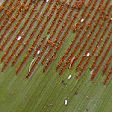 Asplenium australasicum
Asplenium australasicum
Asplenium australasicum is susceptible to Coconut Scale or Fern Scale (Pinnaspis aspidistrae). It is normally found on the under side of the fronds. Small infestations cause little damage.
Bougainvillea species may be attacked by the soft scale (Coccus hesperidum) outdoors or under glass.
Calluna and Vaccinium species are attacked by the Oyster Shell Scale (Lepidosaphes ulmi).
Camellia species may be attacked by the Florida Red Scale (Chrysomphalus aonidum), which is small, circular and black and is found firmly attached to the underside of the leaf along the veins. On inspection after removing the scale the insect has a pale yellow body. Camellias are also attacked by a large variety of scale insects including Tea Scale and Camellia Scale.
Carpinus species may be attacked by the scale (Phenacoccus acericola). It is found on the underside of the leaves forming a white cotton-like clump along the veins.
Casuarina and Allocasuarina species may be attacked by the Casuarina Scale (Frenchia casuarinae), a black hard scale that is upright to 4mm with a pinkish body. During attachment the surrounding tissue swells up and in time can, form galls. This weakens the wood and in severe infestations may kill the tree.
Cotoneaster species are attacked by up to four species of scale including the Oyster Shell Scale (Lepidosaphes ulmi).
Cupressus species are attacked by Bark Scale (Ehrhornia cupressi) is pink and covered in white wax. Heavy infestations cause the leaves to turn yellow or reddish.
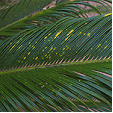 Flat Brown Scale on Cycas revoluta
Flat Brown Scale on Cycas revoluta
Cycads, palms and some species of Callistemon are attacked by the Flat Brown Scale.
Erica species are attacked by several species of scale including, Greedy, Oleander and Oystershell scale.
Jasminum species can be infested with up to twelve types of scale.
Juniperus x media and other conifer species are attacked by the Juniper Scale.
Leptospermum species are attacked by the Tea-tree Scale which produces ample honey dew that promotes sooty mould.
Palm and Fern species are susceptible to attack by the Coconut Scale or Fern Scale (Pinnaspis aspidistrae) which infests the underside of the leaves. They are also hosts for many other scale species such as red, cottony cushion and tea scale.
Pinus species are attacked by several species of scale including the Pine Tortoise Scale (Toumeyella numismaticum) and the Red Pine Scale (Matsucoccus resinosae).
Polygonum odoratum is attacked by a small brown scale.

Sorbus aucuparia is attacked by a five species of scale insect, including Black Cottony Maple, San Jose and Scurfy. Generally they suck on the sap of the new growth and leaves.
Strelitzia species are attacked by the Greedy Scale (Aspidiotus camelliae).
Damage Caused
Leaves become yellow and are shed prematurely and there may be twig or stem die-back. When the infestation occurs on fruit, the fruit is small and its skin becomes pitted and cracked. Small trees and saplings that are heavily infested may be seriously damaged or die. Sooty mould can cover fruit or leaves causing a secondary problem.
Cactus Scale can completely cover the host cactus sucking sap and causing it to die.
Cultural Control
Dead or damaged parts of the plant should be removed and destroyed including fallen fruit. Small infestations may be removed by hand or squashed on the stems. Healthy plants are less susceptible to attack, so maintain vigour of the plant and avoid using high-nitrogen fertiliser that produces excessive soft young growth.
When pruning susceptible plants paint the cuts with antifungal sealant paint as scale insects are attracted to the sweet smell of the sap. This will reduce the infection rate of the plant.
Biological Control
Natural predators such as parasitic wasps may reduce numbers of active nymphs; parasitic wasps are bred commercially in some areas for this purpose. It should be noted, however, that wasps would avoid dusty conditions.
Other predators that assist in control are assassin bugs, ladybirds, lacewings, hover flies and scale eating caterpillars. A variety of birds also attack scales.
The control of ants that transport aphid from one host to another also reduces infestation and can be carried out by applying at least three greased bandages 5mm apart around the stem or trunk of the plant.
Chemical Control
Spray the entire plant with dilute white oil solution; a follow-up spray may be required after four weeks, for heavy infestations. Spraying of chemicals will also kill of natural predators and in some cases the secondary scale infestation is more prolific especially when using copper based chemicals.
Some chemical controls, such as methidathion, are available - please seek advice from your local nursery as to the suitable product for your area.
Note
Always read the label for registration details and direction of use prior to application of any chemicals.
Average Lowest Temperature : 15º C 59º F
USDA : 10, 11, 12
This USDA (United States Department of Agriculture) hardiness zone chart can be used to indicate a plant’s ability to withstand average minimum temperatures. However, other factors such as soil type, pH, and moisture, drainage, humidity and exposure to sun and wind will also have a direct effect on your plant’s survival. Use this chart only as a guide, always keep the other factors in mind when deciding where, when and what to plant.
A plant's individual USDA zone can be found in the Plant Overview.
Climate Description
Tropical
This zone may be affected by the monsoon or have high rainfall periods. Summer temperatures and humid with mild winters.
Frosts and droughts rarely occur. High winds are accompanied with rain.
Plant growth
Tropical native and exotic plants grow well.
| Dictionary | Growth Habit |
| Leaf Type | Botanic Flower Description |
| Leaf Shape | Flower Inflorescence |
| Leaf Arrangement | Fruit Type |
| Leaf Margin | Bark Type |
| Leaf Apex And Bases | Flower Description |